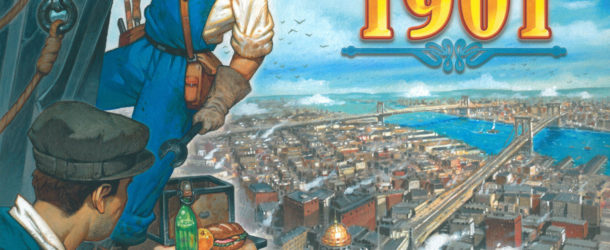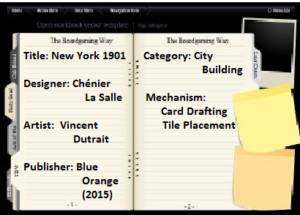Reviewed By Mitch Freedman
I’ve made up a new saying for gamers. Well, half a new saying.
“You can’t judge a book by its cover, and you can’t judge a war game by its cover art.”
It’s really true. It’s something a lot of gamers find out after buying just a few games.
Sooner or later, many gamers use reviews to help decide what to buy, and talk to friends so their gaming group doesn’t have nine copies of Axis and Allies or Descent into Madness.
We pick games because we want a particular period or a style of gaming. There are lots of ways to divide our purchases – Euro-games, small unit infantry combat, world-wide conflicts. Fantasy or alternate history or games based on writers past. H.P. Lovecraft and Jules Verne come to mind.
But in the end, we are usually happy to find a game with rules that are easy to understand yet complex enough to make it special. We feel lucky if the game gives us a worthwhile five or six hours of play time.
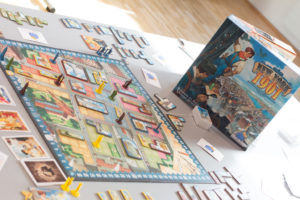 Sometimes, there is a rare game that gives more than we expected. Elegant and simple at the same time. Easy to play but hard to work out and keep a winning strategy. And a game where luck is important and yet kept to a minimum.
Sometimes, there is a rare game that gives more than we expected. Elegant and simple at the same time. Easy to play but hard to work out and keep a winning strategy. And a game where luck is important and yet kept to a minimum.
Which brings me to New York 1901, one of those really rare games that gives you more than you expect, and can be played over and over again by two to four players. The rules say it can be played in an hour, but I doubt that. It just seems like an hour…time really flies when you’re having fun.
I bought New York 1901 on a whim. I liked the retro look, and I liked the idea of building in lower Manhattan, along Broadway and Wall Street at the turn of the century, when steel was making it possible to create the first real skyscrapers.
Simple rules, only four worker figures to hold those all-important vacant building lots, and a rule book that runs only eight pages, with half the space used for pictures to illustrate its rules.
 The game starts simple, but it doesn’t stay that way very long. There is hardly a word about strategy in the rulebook. You start building bronze-level structures on lots you have acquired. They can be replaced by silver-level buildings, and those can be replaced by gold ones, which can never be demolished.
The game starts simple, but it doesn’t stay that way very long. There is hardly a word about strategy in the rulebook. You start building bronze-level structures on lots you have acquired. They can be replaced by silver-level buildings, and those can be replaced by gold ones, which can never be demolished.
Then you find out that the building lots you need can be odd shapes, and you have to cover every square of an odd-shaped building to construct it. Players can pick up building plots and construct a structure on them during the same turn, but you can’t demolish a building and put up a new one on the same lot in the same turn.
And making it even more of a challenge, you can do just one of two things during a turn – buy land or build a skyscraper on lots you have previously acquired. (no money involved, you pick up lots for free).
That’s when you begin to realize that having just four workers to hold vacant lots can be a problem. And when you have no workers left to use and can’t complete a building, you learn just how big a problem it is. You must give back a vacant lot, get back the worker holding it, and just hope that a lot you need will be one of the four cards available to you the next turn. As the rules say, it’s embarrassing.
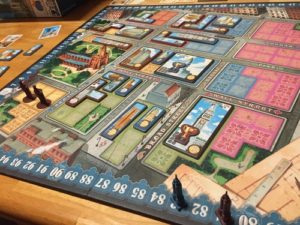 With resources getting scarce, you face the eternal question: Do I take the lot I need to finish my building, or do I scoop up the lot my opponent needs to finish his. Ah, some things never change in gaming.
With resources getting scarce, you face the eternal question: Do I take the lot I need to finish my building, or do I scoop up the lot my opponent needs to finish his. Ah, some things never change in gaming.
But that’s just the bare bones of the game. It’s the bells and whistles that give it the extra fun.
- Every player gets three action cards that allow them to take a second building lot, construct a second building and “shift the market,” which means putting all four building lot cards in the public market at the bottom of the deck and dealing four new ones. Or, you don’t have to use them at all. You get extra points at the end of the game for each card still in your hand.
- There are bonus points at the end of the game which go to the player who has the most skyscrapers built on certain streets.
- There are five bonus challenge cards, and just one is used in a game. They give points for lots of things that might otherwise seem worthless, like having several bronze level skyscrapers still on the board.
So, what you see is what you get, a well-designed game with simple rules and a board that provides a wide range of building options, with the added bonus that it becomes a different game when two, three or four players are gobbling up available land.
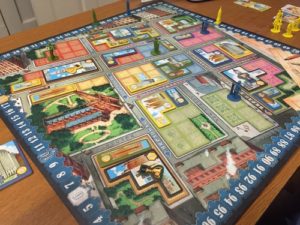 What you don’t see (at least at first) is just how hard it can be to construct an irregular-shaped five hex or regular nine-hex building onto those ever-shifting plots. Or, the possibility that one player will run out of workers (remember the four people) and have to give up one of the parcels of land they own.
What you don’t see (at least at first) is just how hard it can be to construct an irregular-shaped five hex or regular nine-hex building onto those ever-shifting plots. Or, the possibility that one player will run out of workers (remember the four people) and have to give up one of the parcels of land they own.
And, let’s not forget the legendary skyscrapers that players compete to build. Another puzzle to be solved.
Still, no game is perfect. And, there are some flaws in New York 1901. This is a classic euro-game, and the designer is a Canadian diplomat. So, you will read in the rules that you should be courteous as you play, and it’s only right to warn your opponents a turn before you are ready to go out and end the game, just to give them a chance to grab a few more points, enough to let them win.
Yeah.
 New York 1901 BGG page:
New York 1901 BGG page: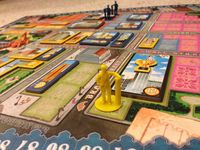
New York 1901 Rules – Version 2.0
Family Game Review


